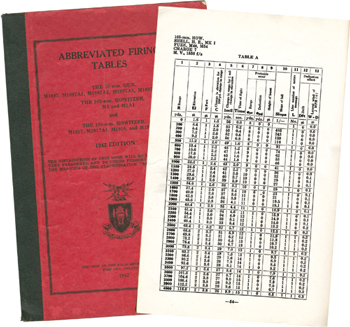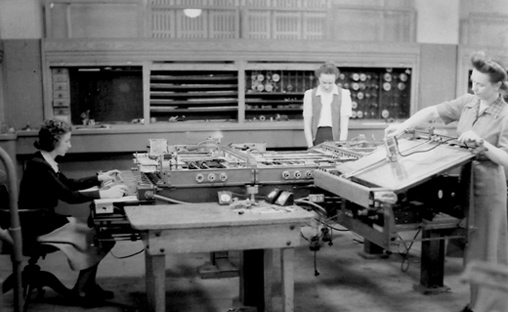In a top-secret program, talented, young female mathematicians calculated the artillery and bomb trajectories that American GIs used to win World War II
The air at 20,000 feet above Schweinfurt, Germany, was icy cold, but the bombardier crouching in the nose of the B-17 hardly noticed. Sweat poured down his forehead as flak rocked the aircraft, periodically spattering his compartment's Plexiglas bubble with fragments. He focused intently on preparing for the final bombing run. He bent over the Norden bombsight, making adjustments with one gloved hand, his other hand grasping a dog-eared booklet filled with numbers—the precise settings he needed to punch into the bombsight to ensure that the B-17's load released at the exact moment necessary to hit its target.
Ten thousand miles away, a Marine sergeant stood next to a 75-millimeter M1A1 pack howitzer on the beachhead of a tiny Pacific Island, surveying a battalion of American soldiers preparing to charge a Japanese hillside position. But before the Marines could advance, the heavily dug-in enemy artillery atop the hill had to be silenced. Ignoring the bullets peppering the sand around him, the sergeant read out a series of numbers from a small chart he held, sending his gun crew scrambling to zero in on the Japanese positions.
Both the bombardier and the artillery sergeant depended on the accuracy of the figures they fed into their weapon systems. If the sergeants had known where those numbers had originated, they probably would have been astonished. The data were the work of a group of remarkable women with a flair for mathematics who were employed by the Army: the Philadelphia Computing Section (PCS) at the University of Pennsylvania. Known as "computers" in an age when that term referred not to machines but to human beings, some of the women went on to help create the first electronic computer, ENIAC. Like the legendary Rosie the Riveters, who toiled in factories and war plants, they were also vital to the war effort, but these computing Rosies worked in secrecy and anonymity, their contributions still largely unknown and unrecognized today.
Math helped propel the military's technological gains of the 20th century. In previous centuries, warfare was literally a hit-or-miss affair. Especially at distances beyond a few feet, weapons were mostly inaccurate, clumsy, and inefficient. Whether aiming a musket across a battlefield or a cannon across the water, a soldier or sailor essentially pointed in the general direction of the enemy, fired, and hoped for a hit. War was also up close and personal: soldiers fired only at what they could see directly. Technological warfare opened the possibility of striking at what one couldn't see—landing an artillery shell on a hidden target over distant hills or dropping a bomb from a high-flying aircraft required firing tables with the correct trajectories, drop points, elevation angles, and muzzle velocities. These calculations also needed to take into account the constantly changing variables of temperature, air density, wind drift, and target position.The "computers" of the Philadelphia Computing Section solved many thousands of complex mathematical formulas to determine accurate artillery shell trajectories, information published in firing table guides, above, that were used by servicemen in combat.
Even before World War II, the Army was busily perfecting an arsenal of new artillery and infantry weapons at its Ballistic Research Laboratory at the Aberdeen Proving Ground in Maryland. To develop the crucial data to operate those weapons, engineers crunched numbers with a Bush differential analyzer, a 30-foot-long mechanical calculating machine developed by MIT's Vannevar Bush in the early 1930s. A cadre of human computers also worked at calculating figures and compiling tables, using pencil, paper, and adding machines. But when America joined the conflict in 1941, the demands of total war forced the Army to enlist more help, and the lab commandeered the resources (and the additional differential analyzer) of the University of Pennsylvania's Moore Engineering School. That meant that a new corps of "computers" had to be assembled quickly to help process the data. With most able-bodied young men already serving in uniform, the Army sought out the most immediately available mathematical talent: young women with a gift for numbers.In addition to hand computing on paper, Kay McNulty, Alyse Snyder, and Sis Stump, above, operated a Bush differential analyzer machine, a mechanical calculating machine developed in the 1930s, which helped crunch the enormous amount of data that went into establishing range projections for a variety of different field artillery pieces.
Principals from many high schools received an SOS from the military, remembered Doris Blumberg, who, along with her twin sister, Shirley, was about to graduate from the Philadelphia High School for Girls in May 1942. "The principal called us in and said that they were recruiting women to do mathematical work at the University of Pennsylvania for the war effort, and that we were qualified." Both girls believed it was their duty to do their part....MUCH MORE

